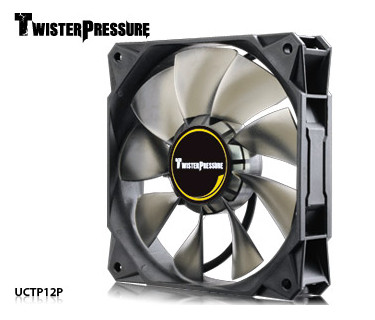Enermax's TwisterPressure Fans Can be Disassembled
Enermax's new fans have not one, but two features that set them apart from the crowd.
Enermax has announced a new fan – the TwisterPressure 120. This fan is built to offer a high static pressure while still operating quietly. The fan also has adjustable maximum speeds, which Enermax refers to as APS (Adjustable Peak Speed).
The peak speeds that the fan can be set to are 1200 RPM, 1500 RPM, and 1800 RPM. The minimum speed is always set at 500 RPM, and in between these the speed is controlled through PWM. At the lowest setting, the fan can push up to 94.5 cubic meters per hour, while the fastest mode will have it push up to 135.85 cubic meters per hour. At these speeds it will push a static pressure of 1.709 and 3.845 mm of water, respectively, and make either 21 or 25 dBA of noise. At 500 RPM, regardless of the speed setting, the fans will push 40.45 cubic meters per hour, push 0.673 mm of water, and make about 14 dBA of noise. All in all, pretty decent numbers.
Enermax has also built the TwisterPressure 120 fan in such a way that you'll be able to remove the fan blade assembly from the rest of the structure, making it much easier to clean than traditional fans.
There is no word yet on pricing or availability, though Enermax fans are usually priced quite reasonably.
Get Tom's Hardware's best news and in-depth reviews, straight to your inbox.
Niels Broekhuijsen is a Contributing Writer for Tom's Hardware US. He reviews cases, water cooling and pc builds.
-
glasssplinter FYI 94.5 cubic meters per hour is 55.6 cfm and 135.85 cubic meters per hour is 79.9 cfm. Those are meaningful numbers and all of the sudden less impressive because chances are when reading the article people see those numbers and think wow, what a fast quiet fan. When buying fans I never see cubic meters per hour, always cfm. It took me 30 seconds to convert that to something that most people would understand, this Tom's is why you are failing. Neat idea for the removable blades but spec wise a Cougar CF-V12HP pushes 2.2 mm H2O at 70.5 cfm with only 17.9 dB which for the low end of the speed on the Enermax makes the Cougar a better choice.Reply -
thundervore Cubic meters per hour? Seriously? I have never seen a case fan measured in 135.85 cubic meters per hour, i always see CFM. Way to confuse the market with high numbers.Reply -
Reaver192 I bet they got a kick back for putting this article in here today using a measurement that 90% would not spend the time to break down. Toms is rather boring on the news front today......... Seriously give me something interesting to read todayReply -
squirrelboy wow, people are getting mad because internationally accepted standards are being used.Reply -
PEJUman Adjustable peak speed: My simple guess is a PWM FAN with an adjustable inline resistor to drop the maximum supply voltage down from its 12V supply. But this will not be able to maintain 500 RPM low speed without an actual RPM controller... I find it hard to believe a simple computer fan could have a build in speed controller.Reply -
glasssplinter Replywow, people are getting mad because internationally accepted standards are being used.
So I'll take the bait on this one. The article was published in the US for US consumers. Unfortunately the US is still backwards and uses the worthless SI system instead of metric. Nevertheless, being that they published it in an area that uses the SI system, most consumers won't know what the international standards mean here. That's where the gripe comes in, backward and useless as it may be we still use the SI system and most have little grasp of the big and scary metric system. It's called knowing your target audience. If it had "Source: Tom's Hardware International" then there would be no gripe.

